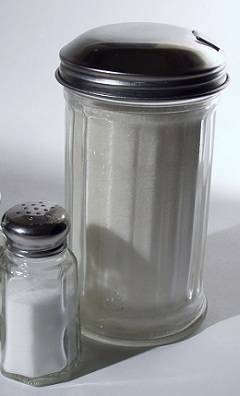If you are anything like I, food just does not taste right without a little salt and you are a sucker for sweet stuff too. But what amount of salt and sugar should you eat each day? Great question, you constantly hear that you should limit your intake of salt and sugar, especially if you’re on a diet and trying to lose weight. But what constitutes as an amount that is accepted as safe and healthy?
To help you put an actual quantity figure to the amount of salt and sugar you should be eating, The Times Of India has laid out the facts so that you will no longer be confused.
The Amount Of Salt And Sugar You Should Eat Each Day

Salt & Sugar
Sugar and salt makes everything nice, but this is no longer true if you’ve been indulging in them more than your health permits. When stress, unhealthy eating habits, lack of exercise, and processed food combine, the reaction is explosive. Therefore, most of us are in the eternal pursuit to reduce salt and sugar in our daily diets. But is it really necessary? How much is too much and how little is too little? We take a look at the facts about sugar and salt and help you solve the salt and sugar daily consumption mystery
How much sugar and salt do you need everyday?
Salt: According to Dietary Guidelines for Americans 2010, we can consume maximum 2,300 mg in a single day, which means that one can consume approximately one teaspoon of salt every day. But if you have high blood pressure, diabetes or if you are 51 years and older, then stick to less than 1,500 mg of salt a day.
How much sugar and salt do you need everyday?
Sugar: Technically, the amount of sugar you consume depends on how many calories you are allowed to consume each day. An important point to note here is that since sugar has no nutritional benefits, the calories you get from it will always be extra calories, i.e., calories that a healthy diet does not account for on a daily basis. These are extra calories that you can consume when you have meet your nutritional needs.
Divide this amount with the number of calories per gram of sugar, and you will know how much excess sugar you can have.
A safe estimate suggests that you can consume 70gms of sugar (men) and 50g ( women), but it also depends on your age, weight and how active you are through the day.
How you can control sugar and salt on a daily basis:
Sugar is simple carb; therefore, check the label for carbohydrates in sugar-heavy snacks when you’re purchasing them. More than 15gms of total sugars per 100g is high and 5g of total sugars or less per 100g is low.
Opt for 10gms of sugar for a pack of 100gms. Sugar has several different names depending on its form, the most common being sucrose and fructose. The best way to avoid sugar is to avoid processed junk food.
How you can control sugar and salt on a daily basis:
The same holds true for salt as well. If you’re trying to reduce sodium intake, avoid packaged food. Why/ Because salt and sugar are used as preservatives to increase the longetivity of the packed product.
Also, certain raw ingredients like dairy and seashells contain sodium, but the amount is very small. Hence, it doesn’t add to your overall sodium intake. On the other hand, if you’re going to spice up your food with sauces, be aware that sauces contain additional preservatives and salts which spike your sodium count.
But don’t give up salt altogether. A healthy diet needs sodium.
If you are healthy, you do not need to avoid salt completely from your diet; the repercussion could be dangerous for your body. Some of the problems are heavy perspiration, dehydration, low blood pressure, leading to shock.
What makes salt essential to the human body is that it retains water that helps in proper functioning of the body. For instance, if you are prone to cramps, then salt is the answer. Sodium helps the muscle to contract with ease. Thanks to salt, you can taste food as salt activates enzymes, salivary amylase, that allow you to taste food. Salt also breaks down food and helps in digestion. Continue the rest of the article here.
Wow, after reading that I realize how much salt and sugar is actually hidden in process foods. I say hidden because why else would they cleverly disguise the contents with confusing names like sucrose, fructose and sodium. Okay I’m not here to judge your intelligence or anything, I’m sure most of you already know that these are fancy names for sugar and salt, but wouldn’t it make more sense for the consumer to just see the words sugar and salt, spelt out clearly on the packaging?
Anyway, putting my little rant aside, did you found this article helpful? I know I did, think I’ll be referring to it often. You too might want to bookmark this page or jot down those figures for easy reference, so you’ll always know what is a good amount of salt and sugar you should eat each day.
You thought this article was helpful, then why not like it, tweet it, or share it.







No comments yet.